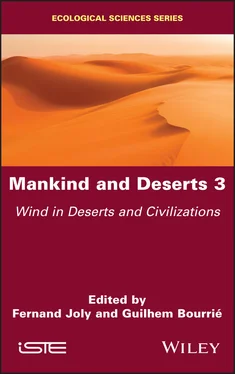1 Cover
2 Title Page Series Editor Françoise Gaill
3 Copyright Series Editor Françoise Gaill
4 Foreword Series Editor Françoise Gaill
5 Introduction: Aeolian Dynamics and Processes
I.1 Conditions and environments in which wind acts
I.2 Aeolian processes
I.3 References
6 1 Aeolian Landforms in Deserts
1.1. Forms and surface states 1.2. Ablation forms
1.3. Accumulation formations
1.4. Aeolian systems
1.5 Ergs, the most complex aeolian systems
1.6 Conclusion: a new paradigm to explain the organization and orientation of active dunes
1.7. Martian dunes, still mobile…
1.8. References
7 2 Humans and Winds in Deserts
2.1 Traditional societies and the wind
2.2. The battle against sand encroachment, or the Barrel of the Danaids: the Zouerate railroads (Mauritania)
2.3 The Dust Bowl, the first ecological disaster of the 20th century in a developed country
2.4. The western Algerian Green Barrier, or an error in management
2.5. References
8 3 Living in Deserts
3.1. Humans and the desert
3.2. Bedouin civilizations
3.3. Hydraulic civilization
3.4. A salt civilization?
3.5. Urban civilizations in the desert
3.6. Conclusion
3.7. References
9 List of Authors
10 Index
11 End User License Agreement
1 IntroductionFigure I.1. A sandy spit that curves around relief in the SE of the Tibesti rang...Figure I.2. Spontaneous Markouba steppes protecting the Nouadhibou – Zouerate ra...Figure I.3. Distribution of areas with wind deposits around the globe (as per Th...Figure I.4. SEM image of a wind-blown sand grain (in the Taghit region of Algeri... Figure I.5. Relation between the ablation velocity, fall velocity and granulomet...
Figure I.6. Dust falling over Aleg (Mauritania) in April 2001. Colors not modifi...Figure I.7. How the roughness of the substrate influences saltation (as per Bagn...Figure I.8. Blowing sand in the Tassili of Hoggar, between Tamanrasset and In Gu...Figure I.9. The mechanism of formation of a deflation pavement: (A) the initial ...Figure I.10. A vehicle that has “fallen” into a fech fech outcrop of the Mekhera...Figure I.11. Satellite image of the area where the “river of sand” begins in Cap... Figure I.12. Views of the soil in the area where the “sandy river” of Cape Juby ...
2 Chapter 1Figure 1.1. Reg. For a color version of this figure, see www.iste.co.uk/bourrie/...Figure 1.2. A serir close to Doush (south of the Kharga depression, Western Dese...Figure 1.3. Discontinuous rust layer in the Kharga depression (Western Desert, E...Figure 1.4. Dreikanter in Ténéré (Niger) (photos F.M. Callot). For a color versi...Figure 1.5. Corrasion lines on a sandstone outcrop in Nubia, in the Kharga depre...Figure 1.6. Corrasion grooves on a limestone block that is about 1.5 m high, loc...Figure 1.7. Árbol de Piedra, a mushroom rock that is 7 m in height in the high-a...Figure 1.8. Yardang in a homogeneous coherent rock in a region with monodirectio...Figure 1.9. Line of yardangs along an Appalachian outcrop of hard rock in the Se...Figure 1.10. Yardangs in the Doush region (Kharga depression, Western Desert, Eg...Figure 1.11. Overview of the Ridge-Corridor system in the SE of the Tibesti (sou...Figure 1.12. The central region of kaluts in the Lut desert (Iran) (source: Goog...Figure 1.13. Ridge-Corridor Systems (RCS) in the Lut desert (Iran) (source: Goog...Figure 1.14. El Hobeur hydro-aeolian depression, to the west of the Oued Namous ...Figure 1.15. Area with sand nappages in presaharan Tunisia. In a case like this,...Figure 1.16. Relationships between the topography, wind direction and aeolian sa...Figure 1.17. Ripple marks on the two faces of a sif (north of the Grand Erg Occi...Figure 1.18. Megaripples. For a color version of this figure, see www.iste.co.uk...Figure 1.19. Diagram and cross-section of a nabkha Figure 1.20. Schematic cross-section of a rebdou Figure 1.21. Rebdous at the foot of Issaouanne n’Tiffernine (Algeria). The struc...Figure 1.22. Zibars in the Erg of Fachi-Bilma (Chad-Niger). For a color version ...Figure 1.23. Stratification within a sif (according to Tsoar (1982)). Note the n...Figure 1.24. The chief components of the barchan (plane and cross-section, accor...Figure 1.25. Crumbling slope of a barchan, near Tarfaya (Morocco). The gently sl...Figure 1.26. The transition from a shield, a shape with no defined edges, to a b...Figure 1.27. Barchan formations to the east of (NW Mauritania) with all the inte...Figure 1.28. Barchan, called “Dune Coursin”, close to Boulanouar (NW Mauritania)...Figure 1.29. Barchans with wings in opposite directions 8 km south of Tarfaya (M...Figure 1.30. Orientation of silks (source: Google Earth) Figure 1.31. The simplest kind of ghourd (Algeria, Grand Erg Occidental, NW of T...Figure 1.32. Ghourd with four edges converging on the summit, or top, in the Nam...Figure 1.33. Large, complex ghourds at the meridional end of the Issaouane n’Tif...Figure 1.34. The ksar of Taghit, at the foot of the ghourds on the western borde...Figure 1.35. Two types of Aklés in Algeria (source: Google Earth) Figure 1.36. The lunette at the Sebkha d’Oran (sketch) constructed leeward of th...Figure 1.37. Sand arrows leeward of the Fachi “cliff” on the meridional border o...Figure 1.38. Two dextrous elbs about a 100 km to the NW of Dirkou (Niger) (sourc...Figure 1.39. Draas in Algeria (source: Google Earth) Figure 1.40. A sahane surrounded by ghourds, silks and aklés in Edeyen d’Oubari ...Figure 1.41. Feidj in the Erg of Fachi-Bilma (Niger), almost entirely covered in...Figure 1.42. Renewed erosion in dunes in the Ogolian erg (Mali). These fixed dun...Figure 1.43. Sand ridges in the Simpson desert 140 km west of Birdsville (source...Figure 1.44. Sand ridge on the eastern border of the Simpson Desert, 40 km from ...Figure 1.45. Arrangements of dunes in the northeastern part of the Grand Erg Occ...Figure 1.46. Ground view and cross-section of the large dunes of the erg. For a ...Figure 1.47. Northern part of the erg in the Registan, clearly limited by the wa...Figure 1.48. Arrangement of dunes in the southern part of the central section of...Figure 1.49. The central and septentrional part of the Grand Erg Occidental (sou...Figure 1.50. Structure of the Grand Erg Occidental (as per Callot 2008, modified...Figure 1.51. Relationship between stationary oscillations and relief features al...Figure 1.52. Simulation of the differences in the creation of the formations in ...Figure 1.53. Dunes leeward of a Martian plateau in the Hellespont region (latitu...Figure 1.54. Detailed views of Martian dunes Figure 1.55. Mars dune blocking a hill, photo from the Curiosity Rover (source: ...
3 Chapter 2Figure 2.1. Fixation of dunes on the left bank of the Niger, east of Timbuktu (p...Figure 2.2. Cross-section of an afreg Figure 2.3. Afregs protecting the Akabli oasis (Algeria). The first dune is over ...Figure 2.4. Afregs in the Douz region (southern Tunisia). The dune is about 15 m...Figure 2.5. Location of the Nouadhibou–Zouerate railroad. The zones marked 1 and ...Figure 2.6. On the Nouadhibou–Zouerate railroad, workers constantly clear one pa...Figure 2.7. Techniques for destroying a barchan that threatens the Nouadhibou–Zo...Figure 2.8. Extent and thickness of loess in the United States with respect to t...Figure 2.9. Two “identical” photographs of Garden City (Kansas) on Black Sunday ...Figure 2.10. Extension of the Dust Bowl and the migrations associated with the p...Figure 2.11. A farmer watching a dust storm in Cimarron county, Oklahoma (photo ...Figure 2.12. A farm buried under aeolian deposits in Dallas (South Dakota) in 19...Figure 2.13. Septentrional Algeria. The Green Barrier was chiefly established at...Figure 2.14. Precipitations in western Algeria and Morocco, as per Dubief 1959–1...Figure 2.15. The lands of the Green Barrier, near the city of El Bayadh, in a se...Figure 2.16. The Green barrier in the Naama region, Algeria (High Plains in the ...Figure 2.17. Aeolian formations around the Kheneg Menhar (meridional dustfall fr...Figure 2.18. Aeolian formations around Kheneg Menhar (the meridional skirt falli...Figure 2.19. Google Earth image of the coalescent barchans, SW of the Djebel Men...Figure 2.20. Directions of the migration of sands and the barchans of Kheneg Men...Figure 2.21. Wind roses showing the potential migration of sands at the Aïn Séfr...
Читать дальше











